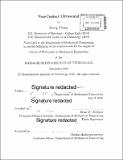Non-contact ultrasound
Author(s)
Zhang, Xiang,Ph. D.Massachusetts Institute of Technology.
Download1139520545-MIT.pdf (17.98Mb)
Other Contributors
Massachusetts Institute of Technology. Department of Mechanical Engineering.
Advisor
Brian W. Anthony.
Terms of use
Metadata
Show full item recordAbstract
This thesis explores the design, development, and evaluation of two novel non-contact ultrasound imaging methods: immersion ultrasound and optical ultrasound. Immersion ultrasound utilizes traditional piezoelectric elements in a tomographic framework to develop new algorithms and acquisition methods for quantification of tissue geometry and properties in human proximal limbs. Bone is uniquely challenging for ultrasound due to the high impedance mismatch between bone and soft-tissue in the imaging domain. New imaging algorithms are necessary for both geometric and quantitative reconstruction of subjects with bone. Multiple immersion systems were designed and constructed using the framework presented in this thesis. Mechanical systems include a 4 degrees of freedom single element system and a fully flexible 36 degrees of freedom robotic system abbreviated MEDUSA (Mechanically Discrete Ultrasound Scanning Apparatus). An adaptive beamforming algorithm addressing specularity of bone in pulse-echo imaging and a Full Waveform Inversion algorithm for quantitative imaging with bone are discussed, with imaging results on tissue mimicking phantoms, excised animal tissue, and human subjects. Furthermore, a laser ultrasound (LUS) system was developed for full non-contact ultrasound imaging. LUS completely replaces conventional piezoelectric elements for generation and detection of ultrasound in biological tissue. LUS generates ultrasonic waves at the tissue surface via rapid transduction of optical energy to acoustic energy through thermomechanical coupling on the tissue surface and detects returning ultrasonic waves on the tissue surface using laser interferometry. In combination, LUS can utilize any tissue surface as a viable acoustic transmitter or detector. Analysis of light and tissue interactions presented in this thesis identifies the critical process parameters for soft-tissue imaging at eye and skin safe optical exposure levels. LUS system design methods and imaging results on tissue mimicking phantoms, excised tissue, and humans subjects are presented. Human LUS results marks the first instance of full non-contact optical ultrasound imaging of in-vivo human subjects. All systems presented in this thesis were calibrated to ensure safe optical and acoustic exposure levels for human subjects. Approval was obtained from the MIT Committee on the Use of Humans as Experimental Subjects (COUHES) prior to any human experimentation.
Description
Thesis: Ph. D., Massachusetts Institute of Technology, Department of Mechanical Engineering, 2019 Cataloged from PDF version of thesis. Includes bibliographical references (pages 145-157).
Date issued
2019Department
Massachusetts Institute of Technology. Department of Mechanical EngineeringPublisher
Massachusetts Institute of Technology
Keywords
Mechanical Engineering.